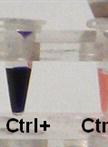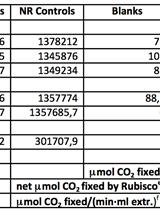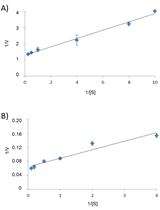- EN - English
- CN - 中文
Determination of Recombinant Mannitol-1-phosphatase Activity from Ectocarpus sp.
水云属中重组甘露醇-1-磷酸酶活性的测定
发布: 2016年08月20日第6卷第16期 DOI: 10.21769/BioProtoc.1896 浏览次数: 9015
评审: Valentine V TrotterYanjie LiAnonymous reviewer(s)
Abstract
Brown algae belong to a phylogenetic lineage distantly related to green plants and animals, and are found predominantly, but not exclusively, in the intertidal zone, a harsh and frequently changing environment. Because of their unique evolutionary history and of their habitat, brown algae feature several peculiarities in their metabolism. One of these is the mannitol cycle, which plays a central role in their physiology, as mannitol acts as carbon storage, osmoprotectant, and antioxidant. This polyol is derived directly from the photoassimilate fructose-6-phosphate via the action of a mannitol-1-phosphate dehydrogenase (M1PDH, EC 1.1.1.17) and a mannitol-1-phosphatase (M1Pase, EC 3.1.3.22). This protocol describes the biochemical characterization of a recombinant M1Pase of Ectocarpus sp. The M1Pase enzyme catalyzes the conversion of mannitol-1-phosphate to mannitol (Figure 1).
Figure 1. Reaction catalyzed by a mannitol-1-phosphatase
Materials and Reagents
- UV-Star® PS microplate (96 well) (Greiner Bio-One GmbH, catalog number: 655801 )
- 0.22 µm filter
- Escherichia coli BL21 (DE3)
- Trizma® base (Sigma-Aldrich, catalog number: T1503 )
- Purified recombinant His-tagged M1Pase
Note: This protein was produced in Escherichia coli BL21 (DE3) containing the recombinant pFO4_ M1Pase vector, as described by Groisillier et al. (2010). This recombinant protein was purified by affinity chromatography using a HisPrep FF 16/10 column (GE Healthcare) onto an Äkta avant system (GE Healthcare). The complete purification protocol is described in details in Groisillier et al. (2014). - MgCl2 (Sigma-Aldrich, catalog number: M8266 )
- MilliQ water
- Malachite green phosphate assay kit (Gentaur, catalog number: POMG-25H )
Note: Malachite green phosphate assay protocol is available at https://www.bioassaysys.com/Datasheet/POMG.pdf. - Examples of chemicals to be tested to assess substrate specificity
- D-mannitol-1-phosphate (Sigma-Aldrich, catalog number: 92416 )
- D-fructose-1-phosphate (Sigma-Aldrich, catalog number: F1127 )
- D-glucose-1-phosphate (Sigma-Aldrich, catalog number: G9380 )
- D-mannose-6-phosphate (Sigma-Aldrich, catalog number: M3655 )
- D-glucose-6-phosphate (Sigma-Aldrich, catalog number: G7879 )
- D-fructose-6-phosphate (Sigma-Aldrich, catalog number: F3627 )
- NaCl (Sigma-Aldrich, catalog number: 71380 )
- 1 M Tris-HCl (pH 7.5) (see Recipes)
- 100 mM MgCl2 (see Recipes)
- 5 M NaCl (see Recipes)
Equipment
- NanoDrop 2000 spectrophotometer (Thermo Fisher Scientific, model: NanoDrop 2000 )
- Safire2 UV spectrophotometer microplate reader (Tecan Trading AG)
Software
- Hyper32 (Informer Technologies, http://hyper32.software.informer.com/)
- Microsoft Excel
Procedure
文章信息
版权信息
© 2016 The Authors; exclusive licensee Bio-protocol LLC.
如何引用
Groisillier, A. and Tonon, T. (2016). Determination of Recombinant Mannitol-1-phosphatase Activity from Ectocarpus sp.. Bio-protocol 6(16): e1896. DOI: 10.21769/BioProtoc.1896.
分类
植物科学 > 藻类学 > 蛋白质 > 活性
生物化学 > 蛋白质 > 活性
您对这篇实验方法有问题吗?
在此处发布您的问题,我们将邀请本文作者来回答。同时,我们会将您的问题发布到Bio-protocol Exchange,以便寻求社区成员的帮助。
Share
Bluesky
X
Copy link















